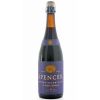The Spencer Brewery - Monk’s Reserve Ale
-
ABV:
10.2% -
Bottle Size:
750-ml -
Serving Temperature:
47–53° F -
Suggested Glassware:
Chalice, Tulip, or Pinot Glass
One of our two featured beers this month is Spencer Brewery’s delicious Monk’s Reserve Ale, a potent Trappist quadrupel that’s a standout example of this harder-to-find style. This beer has seen very limited distribution so far, with fewer than 100 cases sold in the U.S. this past year, most of which was sold in Massachusetts. As the lone American Trappist brewery, Spencer’s been putting together some standout Belgian styles. And the brewers learned from some of the best—having studied from Trappist breweries like Westmalle and Westvleteren.
Monk’s Reserve Ale pours a deep, cola-brown color with mahogany accents. Not a ton of light getting through, and this definitely feels like a robust, burly quad from the initial pour. The foam feels Belgian in execution: creamy textured, with tiny bubbles, firm retention, and lacing that coats the interior of the glass. The early aromatics provide a good sense of what’s to come, packed with dried dark fruits and some subtle berry character, along with warming medium malt notes that range from caramel and toffee to cola and fresh bread. It’s a vibrant combo of maltiness, tempered by a complex fruitiness and white pepper from the ferment.
This is one of the best quads we’ve crossed paths with in a while. From the first sip, Monk’s Reserve Ale offers up layers of rich core malts accentuated by a nicely handled Belgian yeast character. Any sweetness has been tempered well by the fermentation, removing any stickier maltiness and providing enlivening carbonation alongside bittering elements of pepper and soft clove. At 10.2% ABV, the alcohol stays nicely tucked away and manifests more as that rounded, vinous fruitiness one hopes for in these beers. With time to warm, this quadrupel gradually shows its full breadth of character: incredibly dense maltiness that gets into plum and currant territory, fresh-baked spice bread, a decadent maltiness that keeps on going. It’s probably our favorite release ever from Spencer—and a world-class take on the quadrupel.
The brewery suggests storing bottles of Monk’s Reserve Ale upright, and provides a best-by date about three or four years after bottling. Quadrupels can be amongst the most satisfying of styles to cellar: hefty in ABV, feisty when young, and built to develop some of those most pleasant aged aspects, like sherry notes and complex caramelization. For pairing: the Monk’s Reserve Ale’s emphasis on dark fruit has us looking to heartier pork and duck preparations.
For many of us lovers of craft beer, our first foray into the world of Belgium’s amazing ales came after stumbling across one of the famous Belgian Trappist monastery beers produced by Chimay, Westmalle, Orval, Rochefort, Achel, or, less likely due to its typical absence on these shores, Westvleteren. However, not all of the Trappist breweries are actually located in Belgium, and several new Trappist breweries have opened around the world in recent years. There are now fourteen certified Trappist breweries, all of which are located in Europe, with the exception of this month’s featured brewery—Spencer Brewery, which opened in 2013.
So what is a “Trappist” anyway? “Trappist” is the common term for the monasteries of the Cistercian Order of the Strict Observance, which encompasses dozens of monasteries from around the world. The monks live according to the Rule of St. Benedict, which dates to the 6th century and emphasizes prayer and work. As such, for over six decades the Trappist brothers of St. Joseph’s Abbey in Spencer, MA have produced jams & jellies for sale to the public to support the monastery as well as their charitable assistance to the disadvantaged. In recent years, one of the monks took an interest in brewing and trained at a local brewery. Inspired by him, more monks began to share his interest in brewing—a tradition among monastic communities dating back to the Middle Ages. For two years they gathered info and took multiple trips to visit existing Trappist breweries. Starting with Westmalle and finishing at Sint Sixtus (Westvleteren), the brothers toured around Belgium learning all that they could from their fellow monks—the producers of some of the greatest beers in the world.
Upon completion of their educational travels, the monks of St. Joseph’s voted overwhelmingly to launch their own Trappist brewery—America’s first! Following Trappist tradition, they named their brewery after the abbey’s home of Spencer, Massachusetts. In addition to traditional abbey-style beers, the monks produce styles not typically associated with Trappist breweries, including an IPA (with German and American hops), a German-style Pilsner, a darker “Festive Lager”, and more. As one of our featured beers this month, though, we wanted to focus on the brewery’s core strength, with their exceptional Monk’s Reserve Ale: a full-bodied Trappist quadrupel that’s one of the best examples of this style we’ve found. For more info about the various projects the monks in Spencer are working on, head over to www.spencerabbey.org. And for more about Trappist beers and Trappist monasteries in general, check out the International Trappist Association at www.trappist.be.

Unmatched Variety by style, brewery & country
Choose from Five different Beer Clubs offering unmatched variety by brewery,
country of origin, and beer style to suit your specific tastes.


